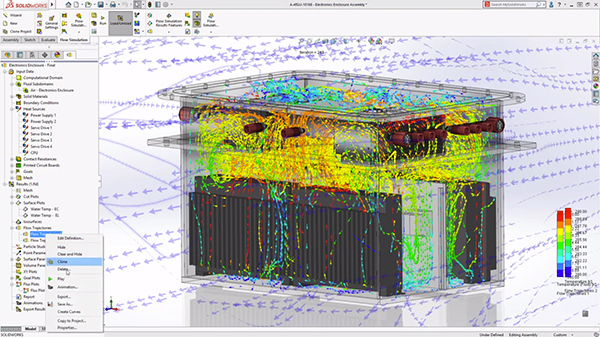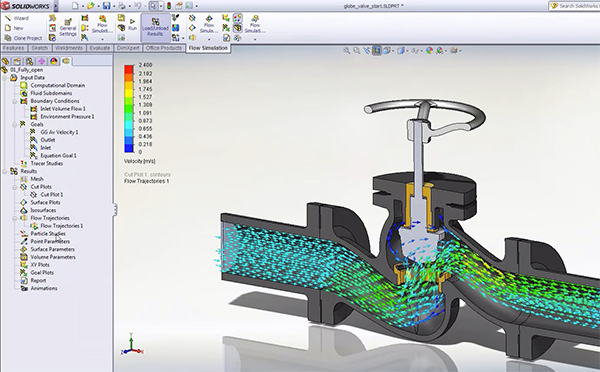
Flow animations are useful in determining how best to cool electronics. Image courtesy of Dassault Systemes SolidWorks.
Latest News
July 16, 2019
The old adage, “a picture is worth a thousand words” applies perfectly to engineering. But sometimes a picture isn’t enough to explain complex designs. So, if a picture of a complex system is worth a thousand words, an animation of a complex assembly must be worth a book.
At many companies, animations are the new standard for sharing high-level product information. Even the simplest of products can be complicated, containing hundreds of intricate parts. Whether it be parts or assemblies or the entire product, more and more designers and engineers are being called upon to create animations to provide a more meaningful explanation. On a larger scale, companies are increasingly turning to animation to share, design and deploy full manufacturing assembly lines.
“An animation that took one day to complete [before using the denoiser] will now be ready over your lunch break.”
Animations are especially important when details are shared with non-engineering team members. They can tell the deeper story of a product’s form and function than still images or CAD models. They are also useful for marketing, helping companies show prospective customers how a product will work.
“In recent years, our customers have found a correlation between product animations and an increase in sales,” says Brian Hillner, the senior product portfolio manager for visualization at Dassault Systemès SolidWorks. “Uploading videos highlighting their competitive advantages to their websites helps their customers understand key product features and ultimately allows them to open up their wallets and make a purchase.”
From Days to Minutes
A decade ago, it would take a full day to create a single photorealistic image. Animations were possible, but they were both time-consuming and rudimentary in quality. Today, the leading MCAD suites include animation either as a core feature or as an add-on that works as part of the basic design software, and several vendors target product engineering with specialized software for photorealistic rendering and animation. All of it works at a speed that feels instantaneous compared to the early days.

With a contemporary workstation, animation content development no longer suffers the bottleneck of inefficient and low-resolution content. The real differentiator is the creative side of making animations. “Designers and engineers no longer need to busy themselves with the technical side of animation,” notes Hillner. “Now they can focus on the creative elements, to help separate ‘just another product animation’ from great content.”
One recent innovation is the new AI-based denoiser technology from NVIDIA, which takes advantage of the Tensor Cores in NVIDIA GPUs, such as those found in the new Quadro RTX range. This technology uses machine learning to anticipate and eliminate the “noise” of screen artifacts that occur in ray tracing, and which until now were hunted down and eliminated using less sophisticated algorithms. Hillner says the NVIDIA denoiser “is insanely fast. An animation that took one day to complete [before using the denoiser] will now be ready over your lunch break.”
Increased digitalization places new demands on the use of simulation and analysis. Animation within engineering becomes a clear way to study simulation of a whole system within its intended environment. This provides context for complicated issues, allowing engineering teams to find flaws or help explain complicated issues.
One example is in the use of animation for studying fill-time results for injection molding. “Animating fill-time results as an addition to using contour plots helps engineers to understand the plastics melt-front,” says Lotfi Derbal, the senior product portfolio manager of SolidWorks Plastics and Flow Simulation. “From just a single animation, the user receives a good example of process quality. Warpage results can also be animated to show how the part is deformed from its original shape to its maximum deformation, helping the designer make important changes to the model.”
Flow Simulation Animation
Animating flow simulation yields significant benefits. Users can understand how the fluid flows inside a domain or externally around a body. The animation of arrows and particles showing fluid density and velocity can provide instant intuitive understanding, as well as make the animation more realistic. Users can also detect and locate recirculation, cavitation, dead regions and turbulence effects. Derbal of SolidWorks says such flow simulation animations also improve efficiency and reduce waste by improving design quality before prototypes or parts are manufactured.
“All these flow simulations let designers and engineers make necessary changes to the model. Users can animate displacements, stresses, factors of safety, temperatures, frequencies and more to predict product performance before they build their products. By animating these qualities and quantities, users can understand how products or full assemblies will perform in real life situations and detect defects before they are put into production.”
As digital twin technology and the Internet of Things (IoT) becomes commonplace, animation will become as important as the geometric model or analysis results for the on-going relationship between the digital product and the physical instantiation. Good animators will be able to create visual results that make densely technical information accessible to a wider audience. There will likely be direct creation of new animations, based on IoT input from the physical device to the digital twin, as well as animations created by engineers and operators.
Subscribe to our FREE magazine, FREE email newsletters or both!
Latest News






